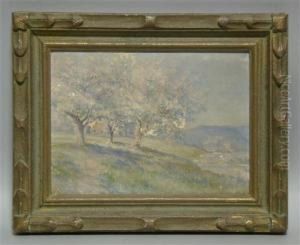Verner White Paintings
Verner White, born in 1863, was an American landscape painter whose work captured the diverse landscapes of the United States, from its bustling cities to its serene countryside. White's artistic journey began in earnest when he studied art under the guidance of renowned artists in the United States and Europe, honing his skills and developing a distinctive style that blended realism with the emerging influences of Impressionism. His education and early career were marked by a traditional approach to landscape painting, but as his style evolved, White began to incorporate lighter brushstrokes and a brighter palette, characteristics that aligned him more closely with the Impressionist movement.
Despite his alignment with Impressionism, White's work retained a unique quality that set it apart from his contemporaries. He had a particular talent for capturing the essence of the American landscape, from the rugged beauty of the Rocky Mountains to the pastoral scenes of the Midwest. His travels across the United States provided him with endless inspiration, and his paintings often depicted the vastness and diversity of the American environment. White's landscapes were not just representations of physical locations; they were imbued with a sense of emotion and atmosphere, often reflecting the changing seasons or the time of day with a remarkable sensitivity to light and color.
White's contributions to American art were recognized during his lifetime, and he was an active member of various art societies and organizations. His works were exhibited across the country, receiving accolades for their technical skill and emotional depth. Despite his success, White remained dedicated to his craft, continually experimenting with techniques and compositions to better capture the landscapes he loved.
Verner White's legacy is that of a painter who bridged the gap between traditional landscape painting and the evolving styles of his time. Through his work, he provided a window into the beauty and diversity of the American landscape, capturing its essence in a way that resonated with both his contemporaries and future generations. White passed away in 1923, but his paintings continue to be admired for their beauty and historical significance, preserving the landscapes he cherished for posterity.



